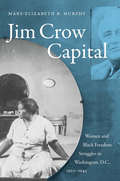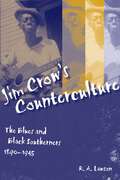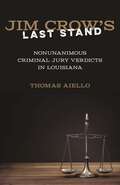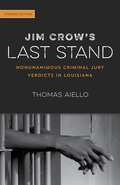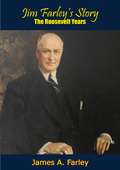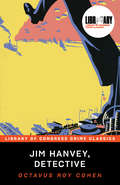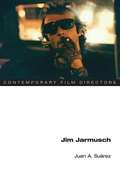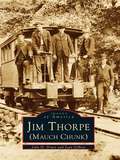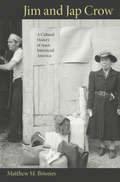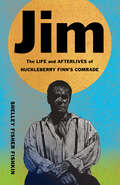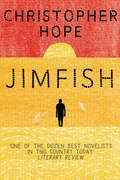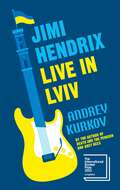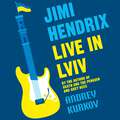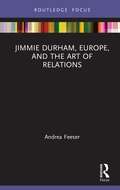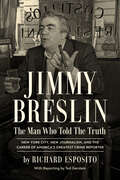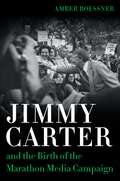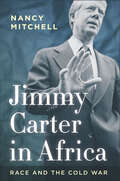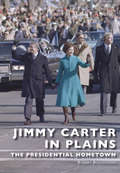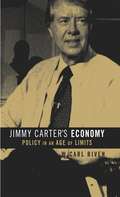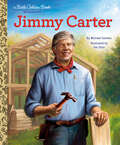- Table View
- List View
Jim Crow Capital: Women and Black Freedom Struggles in Washington, D.C., 1920–1945
by Mary-Elizabeth B. MurphyLocal policy in the nation's capital has always influenced national politics. During Reconstruction, black Washingtonians were first to exercise their new franchise. But when congressmen abolished local governance in the 1870s, they set the precedent for southern disfranchisement. In the aftermath of this process, memories of voting and citizenship rights inspired a new generation of Washingtonians to restore local government in their city and lay the foundation for black equality across the nation. And women were at the forefront of this effort.Here Mary-Elizabeth B. Murphy tells the story of how African American women in D.C. transformed civil rights politics in their freedom struggles between 1920 and 1945. Even though no resident of the nation's capital could vote, black women seized on their conspicuous location to testify in Congress, lobby politicians, and stage protests to secure racial justice, both in Washington and across the nation. Women crafted a broad vision of citizenship rights that put economic justice, physical safety, and legal equality at the forefront of their political campaigns. Black women's civil rights tactics and victories in Washington, D.C., shaped the national postwar black freedom struggle in ways that still resonate today.
Jim Crow's Children
by Peter IronsIn 1954 the U. S. Supreme Court sounded the death knell for school segregation with its decision in Brown v. Board of Education of Topeka. So goes the conventional wisdom. Weaving together vivid portraits of lawyers and such judges as Thurgood Marshall and Earl Warren, sketches of numerous black children throughout history whose parents joined lawsuits against Jim Crow schools, and gripping courtroom drama scenes, Irons shows how the erosion of the Brown decision--especially by the Court's rulings over the past three decades--has led to the "resegregation" of public education in America. .
Jim Crow's Counterculture: The Blues and Black Southerners, 1890-1945 (Making the Modern South)
by R. A. LawsonIn the late nineteenth century, black musicians in the lower Mississippi Valley, chafing under the social, legal, and economic restrictions of Jim Crow, responded with a new musical form -- the blues. In Jim Crow's Counterculture, R. A. Lawson offers a cultural history of blues musicians in the segregation era, explaining how by both accommodating and resisting Jim Crow life, blues musicians created a counterculture to incubate and nurture ideas of black individuality and citizenship. These individuals, Lawson shows, collectively demonstrate the African American struggle during the early twentieth century. Derived from the music of the black working class and popularized by commercially successful songwriter W. C. Handy, early blues provided a counterpoint to white supremacy by focusing on an anti-work ethic that promoted a culture of individual escapism -- even hedonism -- and by celebrating the very culture of sex, drugs, and violence that whites feared. According to Lawson, blues musicians such as Charley Patton and Muddy Waters drew on traditions of southern black music, including call and response forms, but they didn't merely sing of a folk past. Instead, musicians saw blues as a way out of economic subservience. Lawson chronicles the major historical developments that changed the Jim Crow South and thus the attitudes of the working-class blacks who labored in that society. The Great Migration, the Great Depression and New Deal, and two World Wars, he explains, shaped a new consciousness among southern blacks as they moved north, fought overseas, and gained better-paid employment. The "me"-centered mentality of the early blues musicians increasingly became "we"-centered as these musicians sought to enter mainstream American life by promoting hard work and patriotism. Originally drawing the attention of only a few folklorists and music promoters, popular black musicians in the 1940s such as Huddie Ledbetter and Big Bill Broonzy played music that increasingly reached across racial lines, and in the process gained what segregationists had attempted to deny them: the identity of American citizenship.By uncovering the stories of artists who expressed much in their music but left little record in traditional historical sources, Jim Crow's Counterculture offers a fresh perspective on the historical experiences of black Americans and provides a new understanding of the blues: a shared music that offered a message of personal freedom to repressed citizens.
Jim Crow's Last Stand: Nonunanimous Criminal Jury Verdicts in Louisiana
by Thomas AielloThe last remnant of the racist Redeemer agenda in the Louisiana's legal system, the nonunanimous jury-verdict law permits juries to convict criminal defendants with only ten out of twelve votes. A legal oddity among southern states, the ordinance has survived multiple challenges since its ratification in 1880. Despite the law's long history, few are aware of its existence, its original purpose, or its modern consequences. At a time when Louisiana's penal system has fallen under national scrutiny, Jim Crow's Last Stand presents a timely, penetrating, and concise look at the history of this law's origins and its troubling legacy. The nonunanimous jury-verdict law originally allowed a guilty verdict with only nine juror votes, funneling many of those convicted into the state's burgeoning convict lease system. Yet the law remained on the books well after convict leasing ended. Historian Thomas Aiello describes the origins of the statute in Bourbon Louisiana-a period when white Democrats sought to redeem their state after Reconstruction-its survival through the civil rights era of the 1950s and 1960s, and the Supreme Court's decision in Johnson v. Louisiana (1972), which narrowly validated the state's criminal conviction policy. Spanning over a hundred years of Louisiana law and history, Jim Crow's Last Stand investigates the ways in which legal policies and patterns of incarceration contribute to a new form of racial inequality.
Jim Crow's Pink Slip: The Untold Story of Black Principal and Teacher Leadership
by Leslie T. FenwickJim Crow&’s Pink Slip exposes the decades-long repercussions of a too-little-known result of resistance to the Brown v. Board of Education decision: the systematic dismissal of Black educators from public schools.In 1954, the Supreme Court&’s Brown decision ended segregated schooling in the United States, but regrettably, as documented in congressional testimony and transcripts, it also ended the careers of a generation of highly qualified and credentialed Black teachers and principals. In the Deep South and northern border states over the decades following Brown, Black schools were illegally closed and Black educators were displaced en masse. As educational policy and leadership expert Leslie T. Fenwick deftly demonstrates, the effects of these changes stand contrary to the democratic ideals of an integrated society and equal educational opportunity for all students.Jim Crow&’s Pink Slip provides a trenchant account of how tremendous the loss to the US educational system was and continues to be. Despite efforts of the NAACP and other civil rights organizations, congressional hearings during the Nixon administration, and antiracist activism of the 21st century, the problems fomented after Brown persist. The book draws the line from the past injustices to problems that the educational system grapples with today: not simply the underrepresentation of Black teachers and principals, but also salary reductions, teacher shortages, and systemic inequality.By engaging with the complicated legacy of the Brown decision, Fenwick illuminates a crucial chapter in education history. She also offers policy prescriptions aimed at correcting the course of US education, supporting educators, and improving workforce quality and diversity.
Jim Crow’s Last Stand: Nonunanimous Criminal Jury Verdicts in Louisiana
by Thomas AielloA remnant of the racist post-Reconstruction Redeemer sociopolitical agenda, Louisiana’s nonunanimous jury-verdict law permitted juries to convict criminal defendants with only nine, and later ten, out of twelve votes: a legal oddity. On the surface, it was meant to speed convictions. In practice, the law funneled many convicts—especially African Americans—into Louisiana’s burgeoning convict lease system. Although it faced multiple legal challenges through the years, the law endured well after convict leasing had ended. Few were aware of its existence, let alone its original purpose. In fact, the original publication of Jim Crow’s Last Stand was one of the first attempts to call attention to the historical injustice caused by this law. This updated edition of Jim Crow’s Last Stand unpacks the origins of the statute in Bourbon Louisiana, traces its survival through the civil rights era, and ends with the successful effort to overturn the nonunanimous jury practice, a policy that officially went into effect on January 1, 2019.
Jim Farley’s Story: The Roosevelt Years
by James A. FarleyFrank, outspoken and revealing, here is the truth about two of the most controversial political figures in modern America: Franklin D. Roosevelt and Jim Farley. These are the unvarnished facts concerning the man who put Roosevelt into the White House and built up one of the most brilliantly efficient party organizations that America has ever known.Mr. Farley writes of Roosevelt the politician—a human being with human failings—and not a demigod. The full story revealed here for the first time gives a new and surprising picture of the late President, his elaborate political maneuverings, the reasons for the final break with Jim Farley.JIM FARLEY’S STORY is the hard-punching inside account of one man’s meteoric rise to the political genius of the Democratic Party...“Politically, I owe more to Jim Farley than to any other person alive, not excluding my wife!”—Franklin D. Roosevelt
Jim Hanvey, Detective (Library of Congress Crime Classics)
by Octavus CohenFirst published in 1923, Jim Hanvey, Detective is a collection of seven stories that originally appeared in The Saturday Evening Post and features private eye Jim Hanvey in classic whodunit style mysteries. Described as the "backwoods Nero Wolfe," the genial Hanvey befriends "good guys" and criminals alike to get the job done.Bank robberies, jewel heists, and all-purposes cons—none are a match for Octavus Roy Cohen's waddling sleuth.
Jim Jarmusch (Contemporary Film Directors)
by Juan A. SuarezThe first major English-language study of Jarmusch At a time when gimmicky, action-driven blockbusters ruled Hollywood, Jim Jarmusch spearheaded a boom in independent cinema by making low-budget films focused on intimacy, character, and new takes on classical narratives. His minimal form, peculiar pacing, wry humor, and blank affect have since been adopted by directors including Sophia Coppola, Hal Harley, Richard Linklater, and Wong Kar-Wai. Juan A. Suárez's Jim Jarmusch analyzes the director's work from three mutually implicated perspectives: in relation to independent filmmaking from the 1980s to the present; as a form of cultural production that appropriates existing icons, genres, and motifs; and as an instance of postmodern politics. A volume in the series Contemporary Film Directors, edited by James R. Naremore
Jim Thorpe (Images of America)
by John H. Drury Joan GilbertMauch Chunk, now Jim Thorpe, was established on the Lehigh River as a shipping depot for anthracite coal in 1818 by Josiah White, a Philadelphia Quaker and brilliant engineer, and his trusted business partner, Erskine Hazard. By 1829, White and Hazard had founded the Lehigh Coal & Navigation Company and built an efficient transportation system that moved coal nine miles over the mountains to Mauch Chunk by Switchback Gravity Railroad, and forty-six miles along the Lehigh Canal to Easton. With the arrival of the railroads, the Switchback became a major tourist attraction. As rail excursionists descended on Mauch Chunk to experience a hair-raising ride on America's first roller coaster and enjoy the magnificent scenery, the coal shipping town, billed by the railroads as "the Switzerland of America," became a tourist destination second in popularity to Niagara Falls. In a story stranger than fiction, the town exchanged its name for the name of Jim Thorpe when the 1912 Olympic hero was laid to rest there in 1954. Through an extraordinary collection of photographs, Jim Thorpe (Mauch Chunk) tells the story of the athlete and his burial, the Switchback Gravity Railroad, the Lehigh Canal, the social scene, and the town's Victorian legacy.
Jim White's Discovery (Fountas & Pinnell Classroom, Guided Reading Grade 4)
by Barbara Seuling Greg NewboldNIMAC-sourced textbook
Jim and Jap Crow: A Cultural History of 1940s Interracial America
by Matthew M. BrionesFollowing Japan's attack on Pearl Harbor in 1941, the U.S. government rounded up more than one hundred thousand Japanese Americans and sent them to internment camps. One of those internees was Charles Kikuchi. In thousands of diary pages, he documented his experiences in the camps, his resettlement in Chicago and drafting into the Army on the eve of Hiroshima and Nagasaki, and his postwar life as a social worker in New York City. Kikuchi's diaries bear witness to a watershed era in American race relations, and expose both the promise and the hypocrisy of American democracy. Jim and Jap Crow follows Kikuchi's personal odyssey among fellow Japanese American intellectuals, immigrant activists, Chicago School social scientists, everyday people on Chicago's South Side, and psychologically scarred veterans in the hospitals of New York. The book chronicles a remarkable moment in America's history in which interracial alliances challenged the limits of the elusive democratic ideal, and in which the nation was forced to choose between civil liberty and the fearful politics of racial hysteria. It was an era of world war and the atomic bomb, desegregation in the military but Jim and Jap Crow elsewhere in America, and a hopeful progressivism that gave way to Cold War paranoia. Jim and Jap Crow looks at Kikuchi's life and diaries as a lens through which to observe the possibilities, failures, and key conversations in a dynamic multiracial America.
Jim: The Life and Afterlives of Huckleberry Finn's Comrade (Black Lives)
by Shelley Fisher FishkinThe origins and influence of Jim, Mark Twain&’s beloved yet polarizing literary figure Mark Twain&’s Jim, introduced in Adventures of Huckleberry Finn (1885), is a shrewd, self‑aware, and enormously admirable enslaved man, one of the first fully drawn Black fathers in American fiction. Haunted by the family he has left behind, Jim acts as father figure to Huck, the white boy who is his companion as they raft the Mississippi toward freedom. Jim is also a highly polarizing figure: he is viewed as an emblem both of Twain&’s alleged racism and of his opposition to racism; a diminished character inflected by minstrelsy and a powerful challenge to minstrel stereotypes; a reason for banning Huckleberry Finn and a reason for teaching it; an embarrassment and a source of pride for Black readers. Eminent Twain scholar Shelley Fisher Fishkin probes these controversies, exploring who Jim was, how Twain portrayed him, and how the world has responded to him. Fishkin also follows Jim&’s many afterlives: in film, from Hollywood to the Soviet Union; in translation around the world; and in American high school classrooms today. The result is Jim as we have never seen him before—a fresh and compelling portrait of one of the most memorable Black characters in American fiction.
Jimfish
by Christopher HopeFrom one of South Africa's finest novelists comes a glittering and vivid fable of politics and power. In the 1980s, a small man is pulled up out of the Indian Ocean in Port Pallid, SA, claiming to have been kidnapped as a baby. The Sergeant, whose job it is to sort the local people by color, and thereby determine their fate, peers at the boy, then sticks a pencil into his hair, as one did in those days, waiting to see if it stays there, or falls out before he gives his verdict: "He's very odd, this Jimfish you've hauled in. If he's white he is not the right sort of white. But if he's black, who can say? We'll wait before we classify him. I'll give his age as 18, and call him Jimfish. Because he's a real fish out of water, this one is." So begins the odyssey of Jimfish, a South African Everyman, who defies the usual classification of race that defines the rainbow nation. His journey through the last years of Apartheid will extend beyond the borders of South Africa to the wider world, where he will be an unlikely witness to the defining moments of the dying days of the 20th century. Part fable, part fierce commentary on the politics of power, this work is the culmination of a lifetime's writing and thinking, on both the Apartheid regime and the history of the 20th century, by a writer of enormous originality and range.
Jimi Hendrix Live in Lviv: Longlisted for the International Booker Prize 2023
by Andrey Kurkov"Both a pleasure and a testament to life in Ukraine, before" The Times"Ukraine's greatest living novelist" New European"A Ukrainian Murakami" GuardianA hugely entertaining romp through the beautiful city of Lviv, by the author of Death and the Penguin and Grey Bees, now reporting widely on the Russian invasion of Ukraine, his home country.Strange things are afoot in the cosmopolitan city of Lviv, western Ukraine. Seagulls are circling and the air smells salty, though Lviv is a long way from the sea . . . A ragtag group gathers round a mysterious grave in Lychakiv Cemetery - among them an ex-KGB officer and an ageing hippy he used to spy on. Before long, Captain Ryabtsev and Alik Olisevych are teaming up to discover the source of the "anomalies".Meanwhile, Taras - who makes a living driving kidney-stone patients over cobblestones in his ancient Opel Vectra - is courting Darka, who works nights at a bureau de change despite being allergic to money.The young lovers don't know it, but their fate depends on two lonely old men, relics of another era, who will stop at nothing to save their city. Shot through with Kurkov's unique brand of black humour and vodka-fuelled magic realism, Jimi Hendrix Live in Lviv is an affectionate portrait one the world's most intriguing cities.Translated from the Russian by Reuben Woolley
Jimi Hendrix Live in Lviv: Longlisted for the International Booker Prize 2023
by Andrey Kurkov"Both a pleasure and a testament to life in Ukraine, before" Sunday Times"Ukraine's greatest living novelist" New European"A Ukrainian Murakami" GuardianA love letter to the beautiful city of Lviv, by the author of Death and the Penguin and Grey Bees.Strange things are afoot in the cosmopolitan city of Lviv, western Ukraine. Seagulls are circling and the air smells salty, though Lviv is a long way from the sea . . . A ragtag group gathers round a mysterious grave in Lychakiv Cemetery - among them an ex-KGB officer and an ageing hippy he used to spy on. Before long, Captain Ryabtsev and Alik Olisevych are teaming up to discover the source of the "anomalies".Meanwhile, Taras - who makes a living driving kidney-stone patients over cobblestones in his ancient Opel Vectra - is courting Darka, who works nights at a bureau de change despite being allergic to money.The young lovers don't know it, but their fate depends on two lonely old men, relics of another era, who will stop at nothing to save their city. Shot through with Kurkov's unique brand of black humour and vodka-fuelled magic realism, Jimi Hendrix Live in Lviv is an affectionate portrait one the world's most intriguing cities.Translated from the Russian by Reuben Woolley
Jimmie Durham, Europe, and the Art of Relations (Routledge Focus on Art History and Visual Studies)
by Andrea FeeserThis book investigates Jimmie Durham’s community-building process of making and display in four of his projects in Europe: Something … Perhaps a Fugue or an Elegy (2005); two Neapolitan nativities (2016 and ongoing); The Middle Earth (with Maria Thereza Alves, 2018); and God’s Poems, God’s Children (2017). Andrea Feeser explores these artworks in the context of ideas about connection set forth by writers Ann Lauterbach, Franz Rosenzweig, Pamela Sue Anderson, Vinciane Despret, and Hirokazu Miyazaki, among others. Feeser argues that the materials in Durham’s artworks; the method of their construction; how Durham writes about his pieces; how they exist with respect to one another; and how they address viewers, demonstrate that we can create alongside others a world that embraces and sustains what has been diminished. The book will be of interest to scholars working in contemporary art, animal studies, new materialism research, and eco-criticism.
Jimmie Lee & James
by Steve Fiffer Ardar CohenIn the early months of 1965, the killings of two civil rights activists inspired the Selma-to-Montgomery marches, which became the driving force behind the passage of the Voting Rights Act. This is their story."Bloody Sunday"--March 7, 1965--was a pivotal moment in the civil rights struggle. The national outrage generated by scenes of Alabama state troopers attacking peaceful demonstrators fueled the drive toward the passage of the Voting Rights Acts later that year. But why were hundreds of activists marching from Selma to Montgomery that afternoon? Days earlier, during the crackdown on another protest in nearby Marion, a state trooper, claiming self-defense, shot Jimmie Lee Jackson, a 26-year-old unarmed deacon and civil rights protester. Jackson's subsequent death spurred local civil rights leaders to make the march to Montgomery; when that day also ended in violence, the call went out to activists across the nation to join in the next attempt. One of the many who came down was a minister from Boston named James Reeb. Shortly after his arrival, he was attacked in the street by racist vigilantes, eventually dying of his injuries. Lyndon Johnson evoked Reeb's memory when he brought his voting rights legislation to Congress, and the national outcry over the brutal killings ensured its passage. Most histories of the civil rights movement note these two deaths briefly, before moving on to the more famous moments. Jimmie Lee and James is the first book to give readers a deeper understanding of the events that galvanized an already-strong civil rights movement to one of its greatest successes, along with the herculean efforts to bring the killers of these two men to justice--a quest that would last more than four decades.he historic 1965 voting rights march from Selma to Montgomery. A well-written, well-reported page-turner about our collective struggle for equality and justice . . . hopefully the last chapter in the American Revolution."--Morris Dees, Founder of the Southern Poverty Law Center "Jimmie Lee and James does an excellent job of chronicling a truly American movement. As the book so clearly explains, this was a struggle led by African Americans, but white Americans played a major role. Jews and other denominations added institutional support from every part of America. We suffered and sometimes died together." --Civil rights activist, Rev. C. T. Vivian
Jimmy Breslin: The Man Who Told the Truth
by Richard Esposito“Do not. Confuse me. With. The facts. I tell the truth.” —Jimmy Breslin The first-ever biography of America’s greatest crime reporter In a newspaper career spanning decades, Jimmy Breslin covered the stories that he knew mattered most: the human stories beyond the front page. From the JFK assassination, to the Son of Sam killings, mafia heists, the Crown Heights riots, and the Occupy movement, Breslin’s influential columns captured the lifebeat of the second half of the 20th century. A quintessential New Yorker, Breslin rubbed shoulders with world leaders and neighborhood arsonists, profiled JFK’s gravedigger, and elicited letters from the Son of Sam killer during his reign of terror, all recounted in columns that were personal, blunt, and the truth—at least Jimmy’s version of it. Jimmy Breslin: The Man Who Told the Truth is the first biography of the legendary writer, vividly portrayed by Richard Esposito, a former colleague of the Big Man. From Breslin’s humble beginnings as a copy boy, to winning the 1986 Pulitzer Prize for Commentary, the writer’s life was as fascinating as any of his subjects. With the full cooperation of Breslin’s family and interviews with countless of his former coworkers, friends, and enemies, Esposito has crafted a meticulous and revealing portrait of a complex man who bared his soul to the world in column inches.
Jimmy Carter and the Birth of the Marathon Media Campaign (Media and Public Affairs)
by Amber RoessnerWith the rise of Jimmy Carter, a former Georgia governor and a relative newcomer to national politics, the 1976 presidential election proved a transformative moment in U.S. history, heralding a change in terms of how candidates run for public office and how the news media cover their campaigns.Amber Roessner’s Jimmy Carter and the Birth of the Marathon Media Campaign chronicles a change in the negotiation of political image-craft and the role it played in Carter’s meteoric rise to the presidency. She contends that Carter’s underdog victory signaled a transition from an older form of party politics focused on issues and platforms to a newer brand of personality politics driven by the manufacture of a political image.Roessner offers a new perspective on the production and consumption of media images of the peanut farmer from Plains who became the thirty-ninth president of the United States. Carter’s miraculous win transpired in part because of carefully cultivated publicity and advertising strategies that informed his official political persona as it evolved throughout the Democratic primary and general-election campaigns. To understand how media relations helped shape the first post-Watergate presidential election, Roessner examines the practices and working conditions of the community of political reporters, public relations agents, and advertising specialists associated with the Carter bid. She draws on materials from campaign files and strategic memoranda; radio and TV advertisements; news and entertainment broadcasts; newspaper and magazine coverage; and recent interviews with Carter, prominent members of his campaign staff, and over a dozen journalists who reported on the 1976 election and his presidency.With its focus on the inner workings of the bicentennial election, Jimmy Carter and the Birth of the Marathon Media Campaign offers an incisive view of the transition from the yearlong to the permanent campaign, from New Deal progressivism to New Right conservatism, from issues to soundbites, and from objective news analysis to partisan commentary.
Jimmy Carter in Africa: Race and the Cold War (Cold War International History Project)
by Nancy MitchellIn the mid-1970s, the Cold War had frozen into a nuclear stalemate in Europe and retreated from the headlines in Asia. As Gerald Ford and Jimmy Carter fought for the presidency in late 1976, the superpower struggle overseas seemed to take a backseat to more contentious domestic issues of race relations and rising unemployment. There was one continent, however, where the Cold War was on the point of flaring hot: Africa. Jimmy Carter in Africa opens just after Henry Kissinger's failed 1975 plot in Angola, as Carter launches his presidential campaign. The Civil Rights Act was only a decade old, and issues of racial justice remained contentious. Racism at home undermined Americans' efforts to "win hearts and minds" abroad and provided potent propaganda to the Kremlin. As President Carter confronted Africa, the essence of American foreign policy--stopping Soviet expansion--slammed up against the most explosive and raw aspect of American domestic politics--racism. Drawing on candid interviews with Carter, as well as key U.S. and foreign diplomats, and on a dazzling array of international archival sources, Nancy Mitchell offers a timely reevaluation of the Carter administration and of the man himself. In the face of two major tests, in Rhodesia and the Horn of Africa, Carter grappled with questions of Cold War competition, domestic politics, personal loyalty, and decision-making style. Mitchell reveals an administration not beset by weakness and indecision, as is too commonly assumed, but rather constrained by Cold War dynamics and by the president's own temperament as he wrestled with a divided public and his own human failings. Jimmy Carter in Africa presents a stark portrait of how deeply Cold War politics and racial justice were intertwined.
Jimmy Carter in Plains: The Presidential Hometown (Images of Modern America)
by Robert BuccellatoThe physical connections to most American presidents are deeply rooted in the past and unfamiliar. One can no longer see Washington's birthplace or William Henry Harrison's log cabin. Plains, Georgia, is different, and the attachment Americans have for it remains truly unique. Jimmy Carter in Plains: A Presidential Hometown tells the inspirational story of how one man and his community transformed a nation. When Jimmy Carter, a one-term governor of Georgia, announced his candidacy for president, few took him seriously. Yet, in just two years, he managed to pull off a spectacular and unprecedented victory, thanks to his personal style of politicking and the support of his hometown. Many of his neighbors campaigned for him, and they became known as the "Peanut Brigade." Crowds started to flock to the sleepy hamlet of Plains, making celebrities out of the candidate's mother, younger brother, and daughter. The exceptional photographs of Charles W. Plant guide the reader through the 1976 election, which made Plains "America's hometown."
Jimmy Carter's Economy: Policy in an Age of Limits
by W. Carl BivenThe massive inflation and oil crisis of the 1970s damaged Jimmy Carter's presidency. In Jimmy Carter's Economy, Carl Biven traces how the Carter administration developed and implemented economic policy amid multiple crises and explores how a combination of factors beyond the administration's control came to dictate a new paradigm of Democratic Party politics. Jimmy Carter inherited a deeply troubled economy. Inflation had been on the rise since the Johnson years, and the oil crisis Carter faced was the second oil price shock of the decade. In addition, a decline in worker productivity and a rise in competition from Germany and Japan compounded the nation's economic problems. The resulting anti-inflation policy that was forced on Carter included controlling public spending, limiting the expansion of the welfare state, and postponing popular tax cuts. Moreover, according to Biven, Carter argued that the ambitious policies of the Great Society were no longer possible in an age of limits and that the Democratic Party must by economic necessity become more centrist.
Jimmy Carter: A Little Golden Book Biography (Little Golden Book)
by Michael JoostenHelp your little one dream big with a Little Golden Book biography about Jimmy Carter—small town peanut farmer who became the 39th president of the United States! The perfect introduction to nonfiction for young readers—as well as fans of all ages!This Little Golden Book about Jimmy Carter—the 39th president of the United States and Nobel Peace Prize recipient from Plains, Georgia, who continued to help people well into his nineties by building houses with Habitat for Humanity—is an inspiring read-aloud for young girls and boys. Look for more Little Golden Book biographies:George W. BushJohn McCainRonald ReaganBarack ObamaJoe Biden
Jimmy Carter: and Other Conversations (The Last Interview Series)
by Melville House&“We can choose to alleviate suffering. We can choose to work together for peace. We can make these changes—and we must.&” —Jimmy CarterJames Earl Carter Jr. came from a background of farming and military service to forge an unlikely political career, first as governor of Georgia, and then as the 39th president of the United States.The interviews collected here—four of them never published in book form before—span the arc of Carter&’s long career as a politician, a public servant, and a citizen diplomat. They range from an early joust with conservative commentator William F. Buckley Jr. to his final interview, a moving joint conversation with his wife Rosalynn on the occasion of their 75th wedding anniversary … and, of course, it includes the notorious 1976 Playboy interview wherein Carter remarked that he had &“committed adultery in my heart many times.&”The result is a fascinating look into the mind and soul of one of our most admirable and principled presidents ever.
